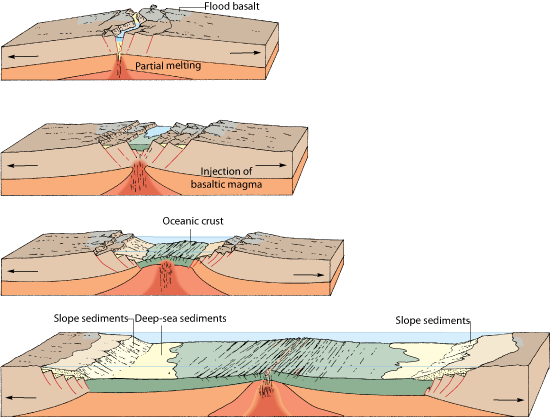 One of the plate margins is divergent (constructive) and this, in short, is when plates move away from each other, thereby generating tensional forces. As such, they are characterised by shallow-focus earthquakes and volcanism, producing volcanoes which erupt basaltic magma (unevolved) via Icelandic and Hawian style eruptions.
One of the plate margins is divergent (constructive) and this, in short, is when plates move away from each other, thereby generating tensional forces. As such, they are characterised by shallow-focus earthquakes and volcanism, producing volcanoes which erupt basaltic magma (unevolved) via Icelandic and Hawian style eruptions. - Start intra-plate
- Upwelling of magma in a plume, driven by thermo-nuclear reactions in the Gutenburg Discontinuity
- Plume rises and convection starts at the base of the lithosphere
- Convection currents rise and then diverge, creating high temperatures that cause updoming of the crust, along with tensional forces that pull it apart
- In continental crust this can produce rift valley systems such as the East African Rift Valley
- In oceanic crust, new oceanic crust is produced as oceanic ridges are created and seafloor spreading occurs
Rifting
- As convection commences the plate is thinned out by a series of extention faults
- As the plate gradually becomes thinner, volcanoes and lakes start to form in the valley
- More volcanoes continue to form until a complete ridge exists, the plate is forced apart and new basaltic oceanic crust begins to form on either side
- As the lakes connect, and the level of the land drops, the ocean floods the valley and forms an elongated sea such as the Red Sea
e.g East African Rift Valley System where eventually a new plate will form (called the Somalia Plate, and the rest of Africa, the Nubia Plate). The sea will eventually flood the valley, connecting to the Red Sea.

 e.g Where spreading occurs beneath major landmasses, heating and subsequent updoming leads to fracturing and rifting. As the sides of the rift move apart, central sections drop down to form rift valleys. The Great East African Rift Valley, indicates where the crust has begaun to pull apart, and active volcanoes such as Mount Kilimanjaro and Mount Kenya are surface evidence of igneous activity beneath. At 4000km long, up to 50km wide and 600m in depth, this feature might widen still, allowing sea inundation. To the north, two rifts have widened into the Red Sea and Gulf of Arabia. Here, the rifting has continued, with new sea floor forming between Africa on the south-western side and Arabia on the north-eastern side.
e.g Where spreading occurs beneath major landmasses, heating and subsequent updoming leads to fracturing and rifting. As the sides of the rift move apart, central sections drop down to form rift valleys. The Great East African Rift Valley, indicates where the crust has begaun to pull apart, and active volcanoes such as Mount Kilimanjaro and Mount Kenya are surface evidence of igneous activity beneath. At 4000km long, up to 50km wide and 600m in depth, this feature might widen still, allowing sea inundation. To the north, two rifts have widened into the Red Sea and Gulf of Arabia. Here, the rifting has continued, with new sea floor forming between Africa on the south-western side and Arabia on the north-eastern side. - Other examples of past rift zones include the steep-sided valley of the River Rhine, athlough there are ancient volcanoes nearby to show how active this region once was, it is no longer subject to rifting.
Oceanic Ridges
 = Lines of submarine volcanoes that form a continuous feature throughout the world's oceans
= Lines of submarine volcanoes that form a continuous feature throughout the world's oceans= Centres of spreading where the youngest oceanic rocks are fund closest to the ridge
- They form the longest continuous uplifted feature, with a total combined length of over 60,000km

- Occur on divergent boundaries as a weaker zone is exposed to an increase in surface heat. Hotter crust expandsa new ridge forms and the central part of the ridge may feature a central valley if a section of crust has subsided into the magma below. This split in the crust provides a lower pressure zone where, if more lava erupts, submarine volcanoes can form. If such eruptions persist then volcanoes will develop until they reach the surface, with islands formed in this way i.e Iceland!

Transform Faults
- Spreading does not occur at the same rate along the ridge
- Transform faults offset the ridge, giving it a blocky appearance
- Distance between the fault varies and they are responsilbe for many undersea earthquakes, but due to a lack of vertical displacement, tsunami's are rarely generated
Hazards
- Frequent low grade seismicity (earthquakes below 5 on Richter Scale)
- Intense and frequent volcanism
- Ultra slow spreading = 10mm/yr i.e Atlantic, Ultra fast spreading = 100mm/yr i.e East Pacific and Galapagos
No comments:
Post a Comment